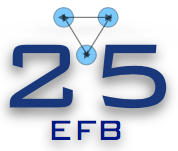Conveners
Monday Parallel Session: NN and Currents (Atrium Maximum)
- Kai Hebeler
Nuclear interactions based on chiral effective field theory ($\chi$EFT) have achieved significant success in describing low-energy nuclear properties. This success can be attributed, in part, to the fitting procedure employed to determine the low energy constants (LECs), which
serve as the free parameters of $\chi$EFT nuclear interactions. However, the description of nuclear electromagnetic...
The nuclear magnetic dipole moment is one of the major probes to investigate the structure of an atomic nucleus. For odd-mass systems, the simplest limit is to consider only the last unpaired nucleon, known as the single-particle or Schmidt limit. The dominance of the single-particle structure relates to the robustness of a magic number in a nucleus, and therefore the magnetic dipole moment...
Considering QCD in the limit of the number of colors $N_c$ being large provides important constraints on the nucleon-nucleon interactions. These constraints are particularly valuable for cases for which available data is limited (if it exists at all), such as for interactions that violate symmetries, e.g., parity and time reversal invariance, and operators contributing to neutrinoless double...
The ongoing progress in derivation the chiral two- and many-nucleon forces in the framework of chiral perturbation theory (χPT) [1,2] gives better and better understanding of nuclear phenomena, but also brings many challenges for application of these forces beyond the two-nucleon (2N) system. While general operator form of three nucleon force (3NF) is currently known up to N4LO [3-6], its...
Recent breakthroughs in quantum many-body methods, computing, and emulators enabled us to statistically investigate nuclear systems and nuclear interactions. We employed a history matching approach to explore the low-energy constants (LECs) domain in delta-full chiral effective field theory. Different constraints such as scattering phase shift and few-body observables are iteratively...
Starting from a complete set of relativistic nucleon-nucleon contact operators preserving parity and time reversal up to order $O(p^4)$ of the expansion in soft momenta $p$, we show that non-relativistic expansions of relativistic operators involve twenty-six independent combinations, two starting at $O(p^0)$, seven at order $O(p^2)$ and seventeen at order $O(p^4)$. This demonstrates the...

